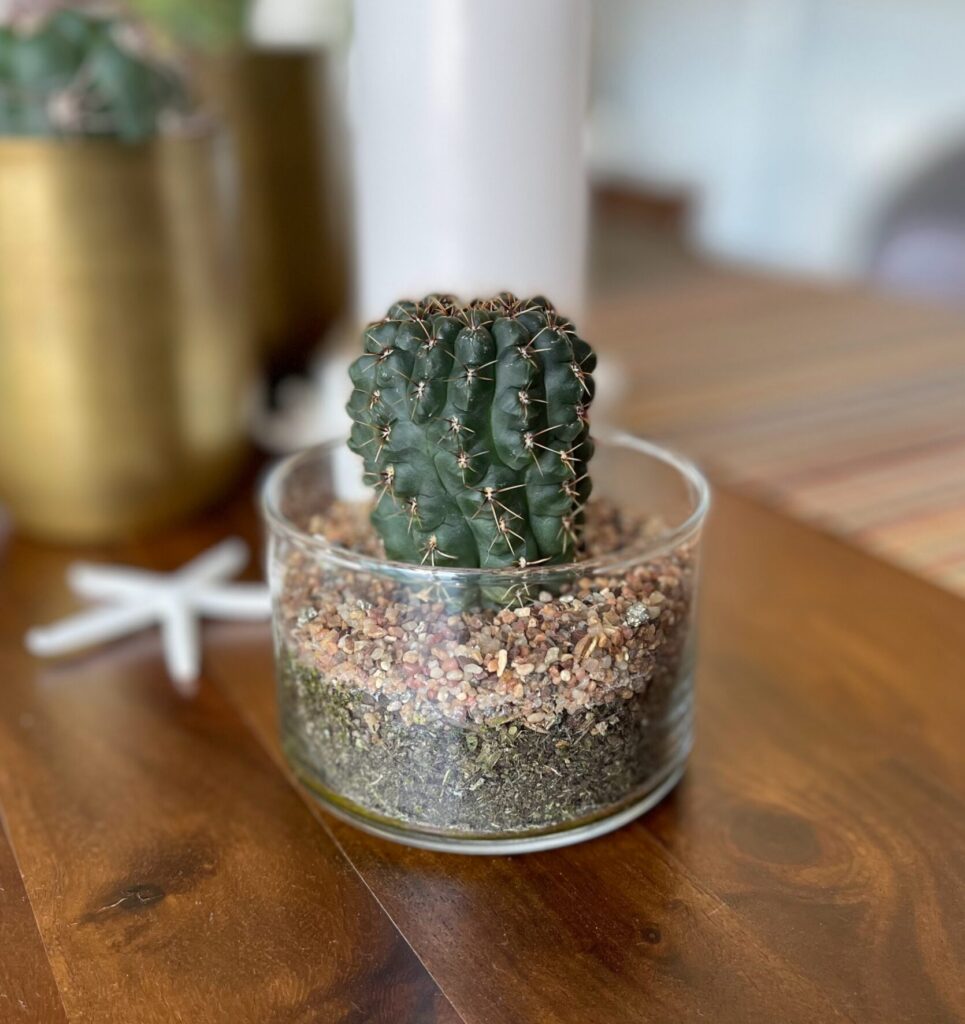Cacti and succulents are some of the most popular and amazing plants in the world. Amongst all other plants, they are considered low-maintenance, inexpensive plants, that are easy to care for.
From lush and green plants to an array of colors, they also come in a variety of shapes, and sizes. This makes them an easy choice to decorate any space, home, or office.
However, many people make common mistakes when taking care of these plants.
In this blog post
We will discuss the 11 most common cacti and succulent mistakes, and how to avoid them!
Succulent Cacti Mistakes: The Short List
- Overwatering
- Not watering enough
- Giving them too much hot direct sunlight
- Giving them too little natural light
- Not planting in the proper soil mix
- Fertilizing improperly
- Forgetting to clean and trim them
- Allowing pests and diseases to take hold
- Keeping them in cold environments for too long
- Choosing the wrong succulent for your climate zone
- Letting them go dormant for too long
1. Watering Habits: Overwatering
It’s easy to make the mistake of overwatering succulents and cacti.
The most common problem associated with overwatering is root rot. This is caused by the plant being left to sit in water for too long. This starves the plant’s roots of oxygen and provides conditions that encourage fungal growth as the roots decompose. If left untreated they will eventually die.
Signs of overwatering
You will notice yellowing or wilting leaves, soft or mushy stems, or obvious rotting stems close to the soil.
To avoid overwatering, it’s important to let the soil dry out completely between waterings.
Depending on the pot’s size ranging from a shallow dish garden to a deep pot as well as the plant type, this can take anywhere from a few days to a couple of weeks.
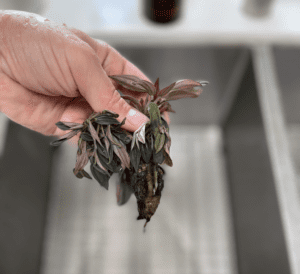
If you’re unsure whether or not to water, it’s always better to err on the side of caution and wait another day or two.
In addition, be sure to empty the tray where the excess water drips from the drainage holes, within 24 hours.
If you think your cacti and succulents are overwatered
There are a few things you can do in an attempt of saving it.
- Remove the plant from the potting soil and gently rinse the soil off of the roots with lukewarm water, while removing any dead or rotten roots.
- Allow the plant to air dry for 3-5 days out of the soil.
- Replant it in a fresh, dry succulent soil mixture.
- Place the pot in a bright spot
- Wait a few more days or enough time so roots begin to grow and then water in the soil.
2. Watering Habits: Not watering enough
Certain species of cacti and succulents can tolerate a tremendous amount of neglect, and usually don’t require a lot of water to thrive.
However, many people make the mistake of not watering at all, which at some point ends the plant’s life.
If this is you, consider creating a watering schedule based on a few months of helicopter plant parenting. The same as all other plants, most cacti, and succulents that are under-watered and over-stressed will be susceptible to a number of problems.
The most common problem is dehydration, which occurs when the plant doesn’t have enough water to carry out its normal daily processes. This will cause the leaves to shrivel and wilt, potentially leading to a dying plant.
Other problems that can be caused by underwatering include
- Stunted growth
- Leaf drop
- Pest infestation
To avoid underwatering your cacti and succulents, it’s important to check in on them at least once a week.
Use your finger or a moisture meter and only water if the soil is or feels completely dry to the touch!
If in doubt it’s ok to take note of the day and wait no more than a week before watering.
3. Giving them too much hot direct sunlight
Bright indirect sunlight is essential for their health, but too much sun can cause scorching among many other problems.
Most succulents and cacti like columnar cacti and prickly pear cactus need plenty of full sunlight in order to thrive. Enough natural light provides them with the energy they need to grow and stay healthy.
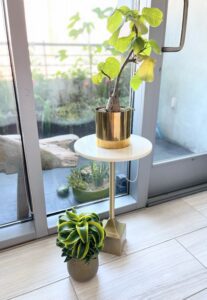

Burning plants, the effects of too much sun
Sunburn occurs when the leaves or stems of these beautiful plants are exposed to an excess of UV radiation. This will cause many species to stress and turn red, brown, or even black and may eventually lead to their demise.
To avoid scorching your succulents and cacti with hot direct sun, it’s important to give them only the amount of sun they need.
Depending on the type of plant, this can range from a few hours a day to full sun all day long.
If you’re not sure how much sun your plant needs
It’s always best to err on the side of caution and only give these plants a few hours to start.
If you see them stretching towards the light, they are showing signs that they need more light.
Note:
Many species of light or pale green tinging towards white or silver plants will have a natural powdery sunblock coating to help prevent burning. Do not wash this off!
4. Giving them too little light
Too little sunlight will cause many cacti to stretch towards the sun or any given light source. Too much stretching will cause them to become deformed, weak, and brittle, this is a sign they need more light.
It’s best to provide them with enough light or at least a few hours of bright light or direct sunlight per day and adjust according to their growth habits.
There are a few succulents, and species of tropical plants or indoor plants in this category that require low light. Plants like the Christmas cactus, jade plant, haworthia, and many varieties of leafy succulents and cacti like Rhipsalis and Epiphyllum.


5. Not planting in the proper soil mix
Most cacti and succulents prefer good soil mixes that are light and sandy and rich in micro-nutrients. This allows the water to drain from the soil quickly, which is essential for these plants.
You can either make your own potting soil or buy a pre-made cacti soil mix at a garden center.
When choosing a soil mix, be sure to avoid soils that are peat-based medium or contain manure or compost. These ingredients can cause the soil to become too wet and lead to root rot.
If you are planting an outdoor garden bed, be sure to use soil that is specifically designed for drought-tolerant plants. This type of soil will allow the water to drain quickly and keep the roots cool.
In addition, you can add gravel or lava rocks to the soil to help with drainage.
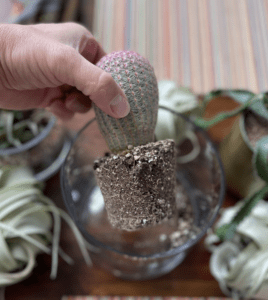
Gardening tips:
Consider temporarily placing shade cloth over newly planted beds to prevent scorching while they are getting established.
6. Fertilizing improperly
When it comes to fertilizing cacti and succulents, there are a few things to keep in mind for these plants’ requirements.
First of all, it’s important to use a fertilizer that is specifically designed for cacti and succulents as opposed to common fertilizers. They require trace minerals and a fertilizer that is low in nitrogen.
They also require higher potassium and phosphorous, which are the nutrients these plants need the most.
In addition, you should only fertilize when they are actively growing. Fertilizing them when they are dormant will not do them any good, and may even harm them.
Finally, you should never fertilize more than once a month when the soil is dry. Fertilizing too often can actually damage your plants.
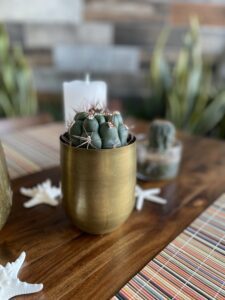
7. Forgetting to clean and trim them
Even these low-maintenance plants need a little TLC from time to time.
Consider giving them a “spa day” to keep them looking their best.
Like most plants, cleaning is an important part of their care.
Not only will it help keep them healthy, but it will also keep most cacti looking their best. There are a few things you can do to clean your succulents and cacti:
- Wipe down larger plants with a damp cloth or sponge. This will remove any dust or dirt that may have built up on the leaves.
- Clean the potting mix to remove any debris that could attract pests.
- Trim off any dead or damaged leaves with scissors. Dead leaves will not grow back, so it’s important to trim them off regularly. Damaged leaves may be able to be repaired if you catch them early enough.
8. Allowing pests and diseases to take hold
Pests and diseases are common problems for succulents and cacti. These plants are not only susceptible to pests and diseases, but they can also be difficult to treat if they become infected.
There are a few pests and diseases and other insects that are particularly common for succulents and cacti.
Some of the most common include:
- Cactus mites are tiny, spider-like creatures that feed on the sap of cacti. They can cause the plant to lose its leaves, and may even lead to death.
- Mealybugs are small, white bugs that attach themselves to the stem or leaves of the plant and suck the sap out of it. They can cause the leaves to become distorted, and may lead to the death of the plant.
- Fungal infections can occur when the soil is too wet or when the plant is injured. The fungus will cause the leaves or stems of the plant to rot and may lead to death.
- Root rot is a condition that occurs when the roots of the plant become too wet. The roots will turn black and mushy, and the plant will not be able to absorb water or nutrients.
If you think they may be infected with pests or diseases, it’s important to take action right away.
There are a few things you can do:
- Isolate plants that are infected! Create a plants-treatment area and isolate the entire pot of plants that are infected to prevent them from spreading.
- Remove any infected leaves or stems from the plant
- Disinfect your scissors or other gardening tools with alcohol or bleach between cuts
- Spray your plants with insecticidal soap or horticultural oil
- Add fungicide to your watering can. Be sure to follow the instructions on the package carefully.
9. Keeping them in cold environments for too long
When it comes to succulents and cacti, most people think that the only thing they need to worry about is watering them properly.
However, cold weather can also be a big problem for these plants.
In fact, cacti and succulents can be very sensitive to cold weather, and may not survive if they are exposed to it for too long.
There are a few things you need to know about how cold weather affects succulents and cacti:
- Cacti are more sensitive to the cold than succulents and may not survive if the temperature drops below freezing.
- Succulents can survive slightly lower temperatures than cacti, but they will still be affected by cold weather. The leaves of succulents may turn brown or die if they are exposed to cold temperatures for too long.
- The best way to protect them from the cold is to move them indoors during winter. You can also cover them with a frost blanket or use a heat lamp to keep them warm.
- If you must keep them outdoors during winter, make sure you protect them from wind and moisture. You can do this by placing them in a sheltered area or using a plant cover.
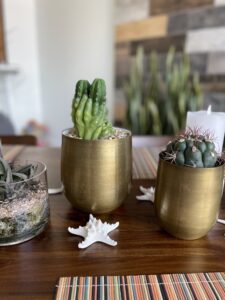
10. Choosing the wrong succulent for your climate zone
Many cactus species grow in a warm climate while being bathed in full sun year-round. While you may have a large selection at your big box store or local nurseries, keep in mind where most species grow.
11. Letting them go dormant for too long
When it comes to succulents and cacti, most people think that the only thing they need to worry about is watering them properly. However, there are other things you need to be aware of as well, such as the effects of neglect. If you don’t water them regularly, they may start to show signs of neglect.
Neglect can cause a number of problems for succulents and cacti, including:
- A Cactus wilt is a condition that occurs when the cactus loses its water supply. The cactus will start to lose its color, and the stem will become soft and floppy. If left untreated, the cactus will die.
- The fungus can infect succulents and cacti when they are watered with dirty water or when the plant is injured. The fungus will cause the leaves or stems of the plant to rot and may lead to death.
- Sunburn can occur when succulents or cacti are exposed to too much sunlight. The leaves of the plant will turn brown or black and may die.
All of these problems can be avoided by watering your succulents and cacti regularly and keeping them in a well-lit location.
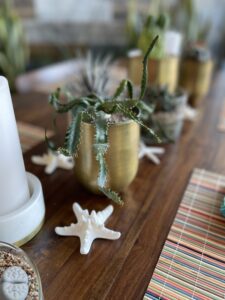

If you’re making any of these common mistakes, don’t worry!
There’s still time to turn things around. By following these simple tips, you can ensure that your cacti and succulents will thrive for years to come.
I hope you enjoyed our blog and will now enjoy growing succulents and cacti on your own.
Thanks for reading!
